Leadership Summative 2: Analysis of Shabnam Bibi's Leadership Style
VerifiedAdded on 2023/03/20
|10
|3432
|21
Report
AI Summary
This report presents an analysis of Ms. Shabnam Bibi's leadership style, based on a semi-structured interview. The study explores her early influences, motivation, and the formation of her leadership approach. The analysis focuses on two prevalent leadership styles: authentic and transformational leadership. The report examines how Ms. Bibi demonstrates characteristics of an authentic leader by establishing honest relationships, being genuine and self-aware, focusing on the long-term, and leading with both mind and heart. It further investigates her alignment with transformational leadership, highlighting her ability to build networks, motivate followers, and encourage collaboration. The report concludes with an assessment of her overall leadership style, drawing insights from the interview data and relevant academic theories.
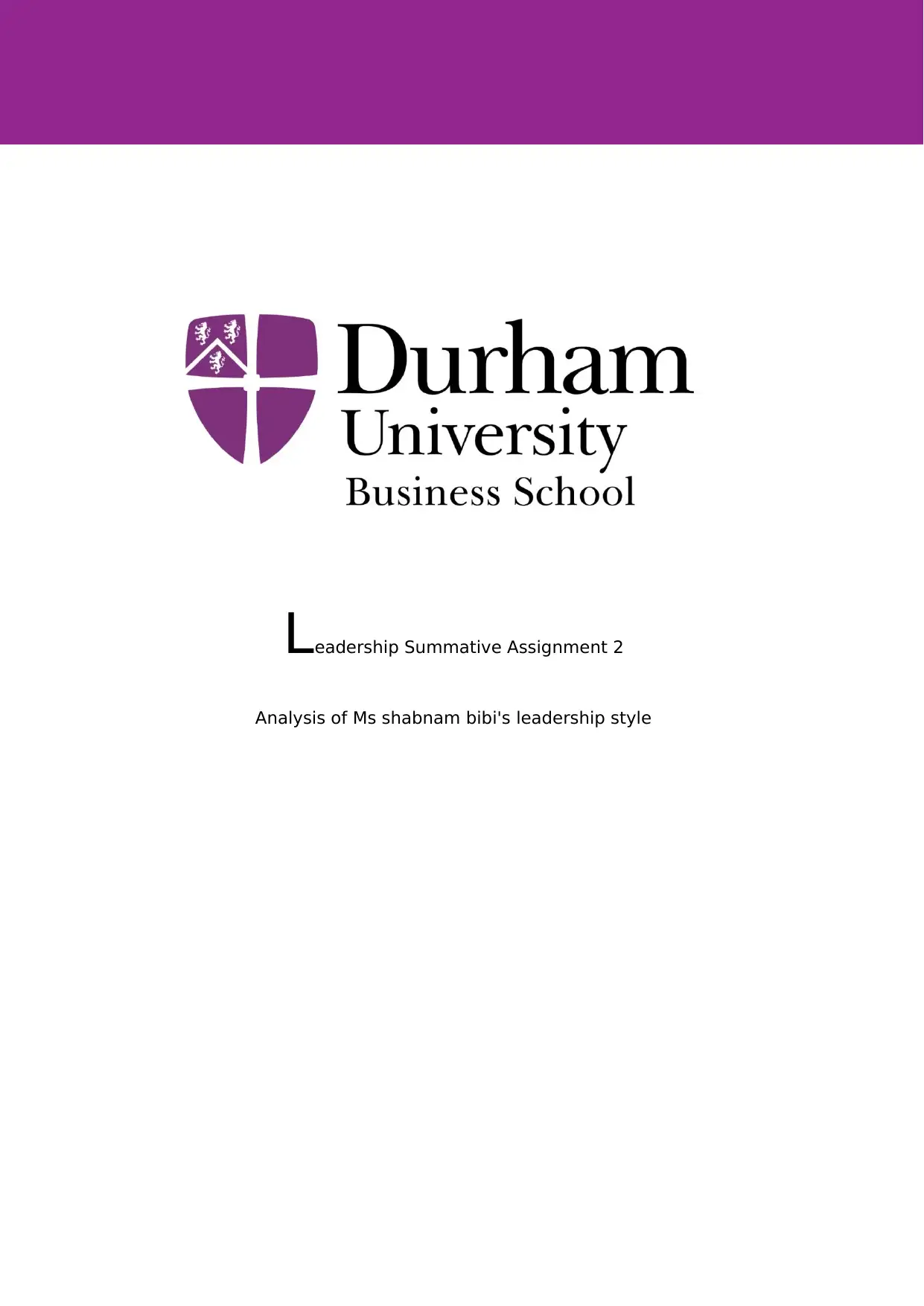
Leadership Summative Assignment 2
Analysis of Ms shabnam bibi's leadership style
Analysis of Ms shabnam bibi's leadership style
Paraphrase This Document
Need a fresh take? Get an instant paraphrase of this document with our AI Paraphraser
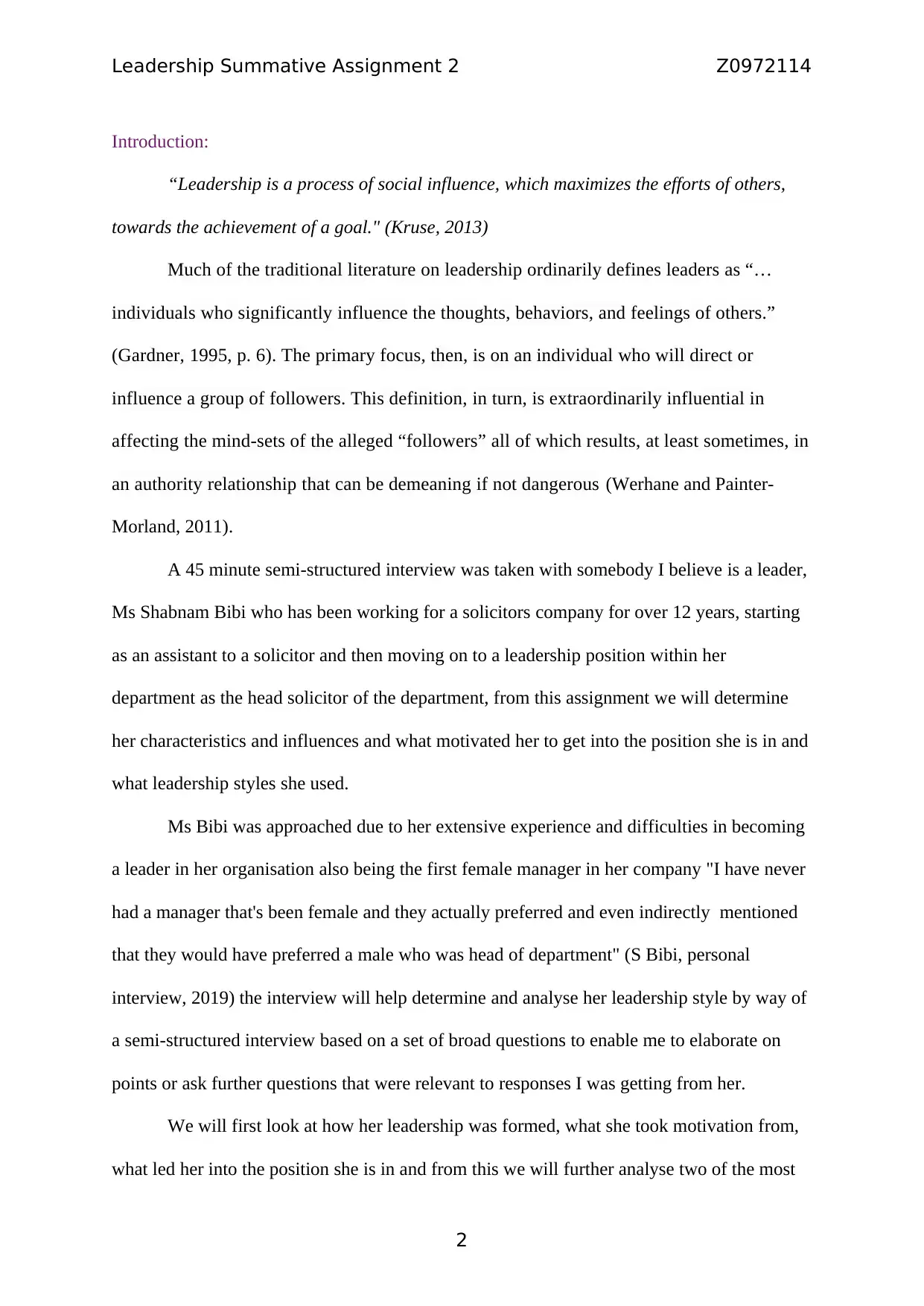
Leadership Summative Assignment 2 Z0972114
Introduction:
“Leadership is a process of social influence, which maximizes the efforts of others,
towards the achievement of a goal." (Kruse, 2013)
Much of the traditional literature on leadership ordinarily defines leaders as “…
individuals who significantly influence the thoughts, behaviors, and feelings of others.”
(Gardner, 1995, p. 6). The primary focus, then, is on an individual who will direct or
influence a group of followers. This definition, in turn, is extraordinarily influential in
affecting the mind-sets of the alleged “followers” all of which results, at least sometimes, in
an authority relationship that can be demeaning if not dangerous (Werhane and Painter-
Morland, 2011).
A 45 minute semi-structured interview was taken with somebody I believe is a leader,
Ms Shabnam Bibi who has been working for a solicitors company for over 12 years, starting
as an assistant to a solicitor and then moving on to a leadership position within her
department as the head solicitor of the department, from this assignment we will determine
her characteristics and influences and what motivated her to get into the position she is in and
what leadership styles she used.
Ms Bibi was approached due to her extensive experience and difficulties in becoming
a leader in her organisation also being the first female manager in her company "I have never
had a manager that's been female and they actually preferred and even indirectly mentioned
that they would have preferred a male who was head of department" (S Bibi, personal
interview, 2019) the interview will help determine and analyse her leadership style by way of
a semi-structured interview based on a set of broad questions to enable me to elaborate on
points or ask further questions that were relevant to responses I was getting from her.
We will first look at how her leadership was formed, what she took motivation from,
what led her into the position she is in and from this we will further analyse two of the most
2
Introduction:
“Leadership is a process of social influence, which maximizes the efforts of others,
towards the achievement of a goal." (Kruse, 2013)
Much of the traditional literature on leadership ordinarily defines leaders as “…
individuals who significantly influence the thoughts, behaviors, and feelings of others.”
(Gardner, 1995, p. 6). The primary focus, then, is on an individual who will direct or
influence a group of followers. This definition, in turn, is extraordinarily influential in
affecting the mind-sets of the alleged “followers” all of which results, at least sometimes, in
an authority relationship that can be demeaning if not dangerous (Werhane and Painter-
Morland, 2011).
A 45 minute semi-structured interview was taken with somebody I believe is a leader,
Ms Shabnam Bibi who has been working for a solicitors company for over 12 years, starting
as an assistant to a solicitor and then moving on to a leadership position within her
department as the head solicitor of the department, from this assignment we will determine
her characteristics and influences and what motivated her to get into the position she is in and
what leadership styles she used.
Ms Bibi was approached due to her extensive experience and difficulties in becoming
a leader in her organisation also being the first female manager in her company "I have never
had a manager that's been female and they actually preferred and even indirectly mentioned
that they would have preferred a male who was head of department" (S Bibi, personal
interview, 2019) the interview will help determine and analyse her leadership style by way of
a semi-structured interview based on a set of broad questions to enable me to elaborate on
points or ask further questions that were relevant to responses I was getting from her.
We will first look at how her leadership was formed, what she took motivation from,
what led her into the position she is in and from this we will further analyse two of the most
2
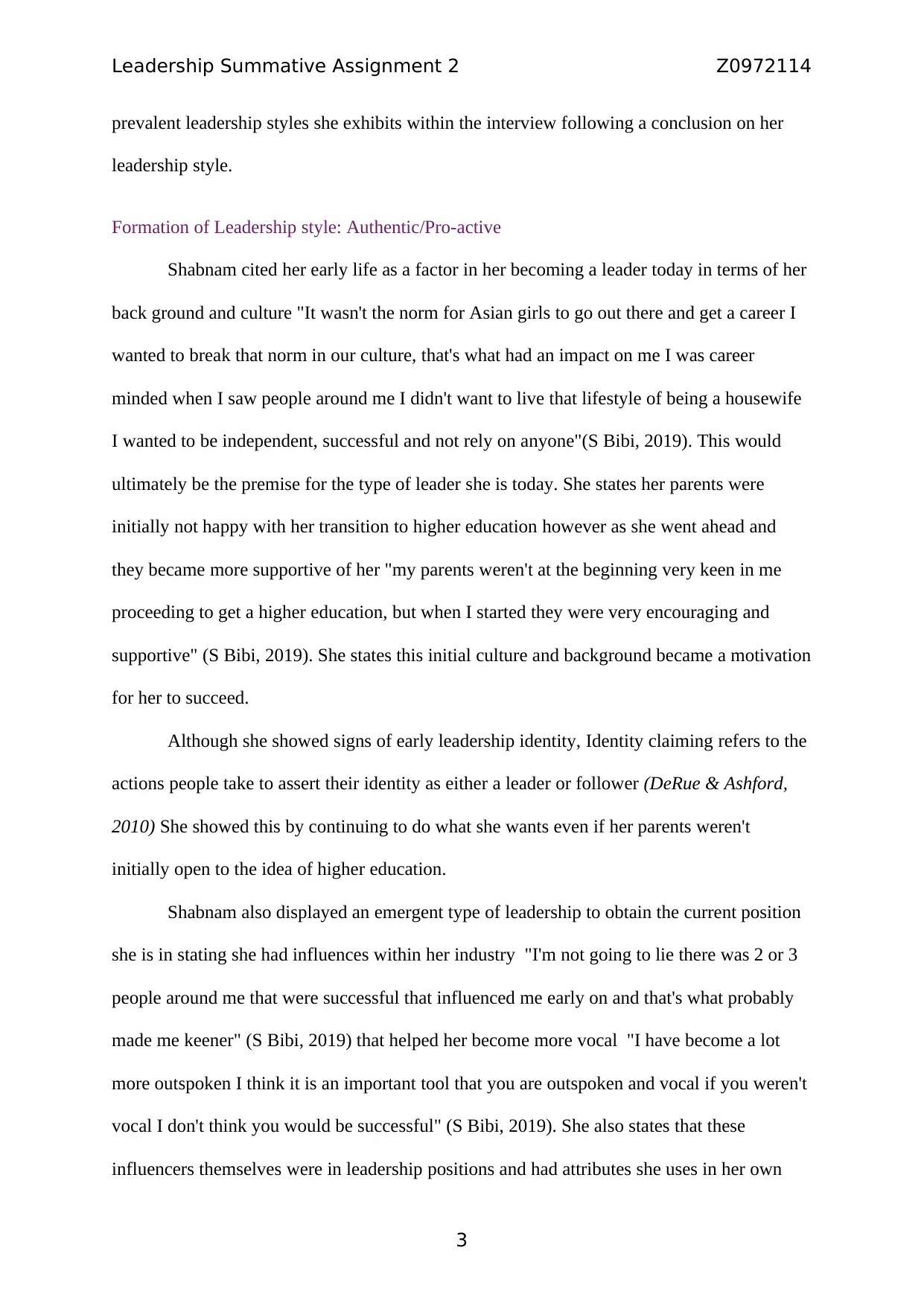
Leadership Summative Assignment 2 Z0972114
prevalent leadership styles she exhibits within the interview following a conclusion on her
leadership style.
Formation of Leadership style: Authentic/Pro-active
Shabnam cited her early life as a factor in her becoming a leader today in terms of her
back ground and culture "It wasn't the norm for Asian girls to go out there and get a career I
wanted to break that norm in our culture, that's what had an impact on me I was career
minded when I saw people around me I didn't want to live that lifestyle of being a housewife
I wanted to be independent, successful and not rely on anyone"(S Bibi, 2019). This would
ultimately be the premise for the type of leader she is today. She states her parents were
initially not happy with her transition to higher education however as she went ahead and
they became more supportive of her "my parents weren't at the beginning very keen in me
proceeding to get a higher education, but when I started they were very encouraging and
supportive" (S Bibi, 2019). She states this initial culture and background became a motivation
for her to succeed.
Although she showed signs of early leadership identity, Identity claiming refers to the
actions people take to assert their identity as either a leader or follower (DeRue & Ashford,
2010) She showed this by continuing to do what she wants even if her parents weren't
initially open to the idea of higher education.
Shabnam also displayed an emergent type of leadership to obtain the current position
she is in stating she had influences within her industry "I'm not going to lie there was 2 or 3
people around me that were successful that influenced me early on and that's what probably
made me keener" (S Bibi, 2019) that helped her become more vocal "I have become a lot
more outspoken I think it is an important tool that you are outspoken and vocal if you weren't
vocal I don't think you would be successful" (S Bibi, 2019). She also states that these
influencers themselves were in leadership positions and had attributes she uses in her own
3
prevalent leadership styles she exhibits within the interview following a conclusion on her
leadership style.
Formation of Leadership style: Authentic/Pro-active
Shabnam cited her early life as a factor in her becoming a leader today in terms of her
back ground and culture "It wasn't the norm for Asian girls to go out there and get a career I
wanted to break that norm in our culture, that's what had an impact on me I was career
minded when I saw people around me I didn't want to live that lifestyle of being a housewife
I wanted to be independent, successful and not rely on anyone"(S Bibi, 2019). This would
ultimately be the premise for the type of leader she is today. She states her parents were
initially not happy with her transition to higher education however as she went ahead and
they became more supportive of her "my parents weren't at the beginning very keen in me
proceeding to get a higher education, but when I started they were very encouraging and
supportive" (S Bibi, 2019). She states this initial culture and background became a motivation
for her to succeed.
Although she showed signs of early leadership identity, Identity claiming refers to the
actions people take to assert their identity as either a leader or follower (DeRue & Ashford,
2010) She showed this by continuing to do what she wants even if her parents weren't
initially open to the idea of higher education.
Shabnam also displayed an emergent type of leadership to obtain the current position
she is in stating she had influences within her industry "I'm not going to lie there was 2 or 3
people around me that were successful that influenced me early on and that's what probably
made me keener" (S Bibi, 2019) that helped her become more vocal "I have become a lot
more outspoken I think it is an important tool that you are outspoken and vocal if you weren't
vocal I don't think you would be successful" (S Bibi, 2019). She also states that these
influencers themselves were in leadership positions and had attributes she uses in her own
3
⊘ This is a preview!⊘
Do you want full access?
Subscribe today to unlock all pages.

Trusted by 1+ million students worldwide

Leadership Summative Assignment 2 Z0972114
position "they were very strong characters, very motivated, very independent, eager and
that's what motivated me" (S Bibi, 2019).
I could see multiple leadership styles in the way Shabnam conducts herself however
we will look into two specific styles that most suit her leadership one being Authentic
Leadership and the other Transformational leadership.
Authentic Leadership:
Authentic leadership is a leadership approach where the primary focus of a leader is
creating legitimacy by way of establishing honest relationships with their subordinates.
Asked whether she has open conversations with her staff, the interviewee responds that” Yes
without a doubt because I think you need to be open with staff as to when you focus on other
things you need other views from both top and bottom of the hierarchy” (S Bibi, 2019).On
top of that, she explains that she always interact with her staff daily. This is an important
characteristic of an authentic leader. Her interactions with staff are based on both work-
related issues and issues outside work.” The thing is I try to interact and be on a good par
with staff members I work with so there are times we discuss things outside of work so we
can have a good understanding and a good relationship so that things could be said a lot
easier if they are not happy with something” (S Bibi, 2019). Such interactions play a major
role in strengthening the relationship bond existing between a leader and followers. It
facilitates honest and open conversations making it possible for employees to air out their
grievances freely. Therefore S Bibi clearly understands the input of honest relationships to
her success as a leader.
Correspondingly, authentic leaders are genuine and self- aware. As individuals, they
are aware of their emotions, limitations, and strengths. The interviewee was aware that
serving as an amateur leader had its limitations (Kruse, 2013 b). After recognizing this fact,
she needed to get in touch with an experienced leader to perfect her leadership skills” Yes I
4
position "they were very strong characters, very motivated, very independent, eager and
that's what motivated me" (S Bibi, 2019).
I could see multiple leadership styles in the way Shabnam conducts herself however
we will look into two specific styles that most suit her leadership one being Authentic
Leadership and the other Transformational leadership.
Authentic Leadership:
Authentic leadership is a leadership approach where the primary focus of a leader is
creating legitimacy by way of establishing honest relationships with their subordinates.
Asked whether she has open conversations with her staff, the interviewee responds that” Yes
without a doubt because I think you need to be open with staff as to when you focus on other
things you need other views from both top and bottom of the hierarchy” (S Bibi, 2019).On
top of that, she explains that she always interact with her staff daily. This is an important
characteristic of an authentic leader. Her interactions with staff are based on both work-
related issues and issues outside work.” The thing is I try to interact and be on a good par
with staff members I work with so there are times we discuss things outside of work so we
can have a good understanding and a good relationship so that things could be said a lot
easier if they are not happy with something” (S Bibi, 2019). Such interactions play a major
role in strengthening the relationship bond existing between a leader and followers. It
facilitates honest and open conversations making it possible for employees to air out their
grievances freely. Therefore S Bibi clearly understands the input of honest relationships to
her success as a leader.
Correspondingly, authentic leaders are genuine and self- aware. As individuals, they
are aware of their emotions, limitations, and strengths. The interviewee was aware that
serving as an amateur leader had its limitations (Kruse, 2013 b). After recognizing this fact,
she needed to get in touch with an experienced leader to perfect her leadership skills” Yes I
4
Paraphrase This Document
Need a fresh take? Get an instant paraphrase of this document with our AI Paraphraser
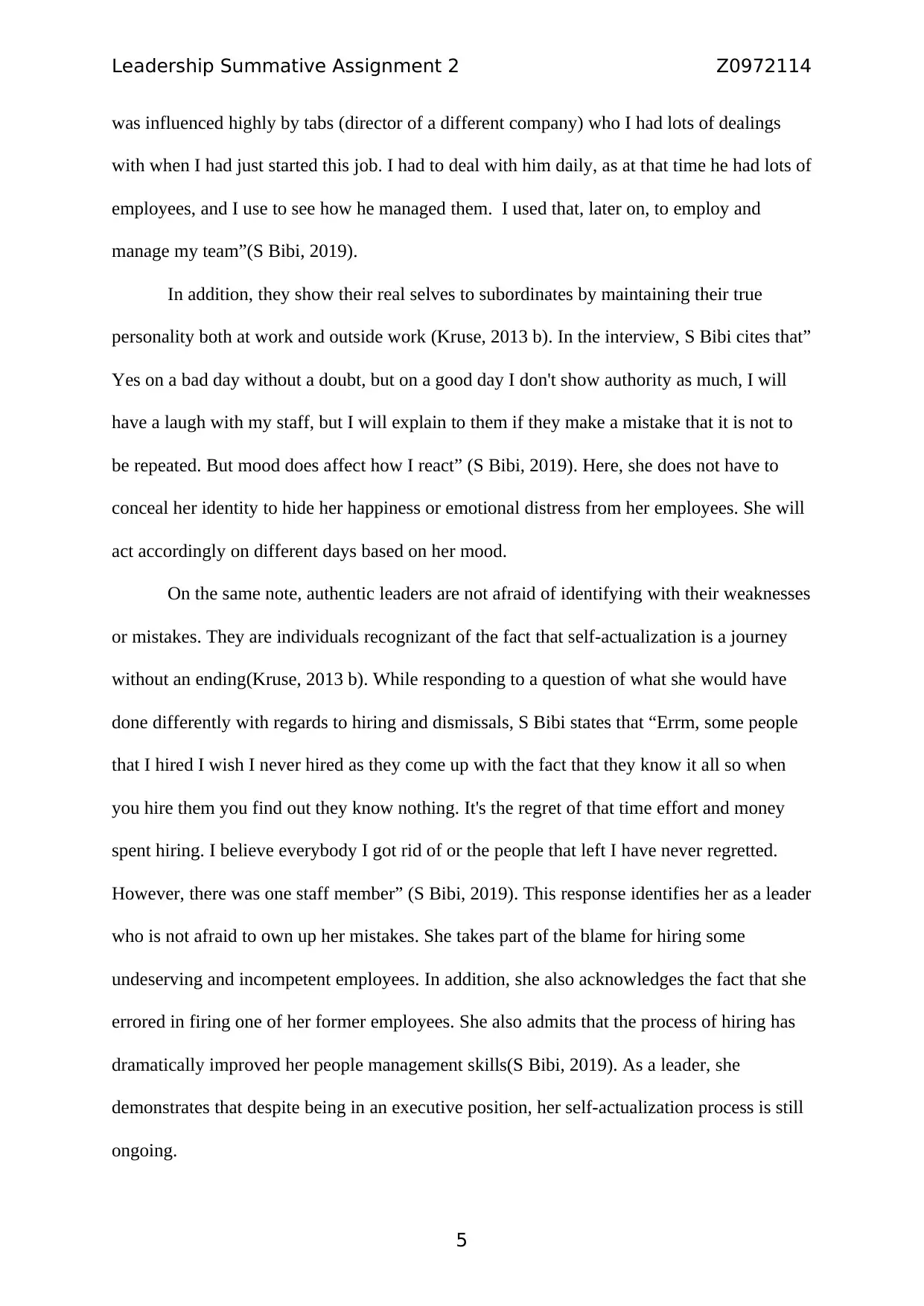
Leadership Summative Assignment 2 Z0972114
was influenced highly by tabs (director of a different company) who I had lots of dealings
with when I had just started this job. I had to deal with him daily, as at that time he had lots of
employees, and I use to see how he managed them. I used that, later on, to employ and
manage my team”(S Bibi, 2019).
In addition, they show their real selves to subordinates by maintaining their true
personality both at work and outside work (Kruse, 2013 b). In the interview, S Bibi cites that”
Yes on a bad day without a doubt, but on a good day I don't show authority as much, I will
have a laugh with my staff, but I will explain to them if they make a mistake that it is not to
be repeated. But mood does affect how I react” (S Bibi, 2019). Here, she does not have to
conceal her identity to hide her happiness or emotional distress from her employees. She will
act accordingly on different days based on her mood.
On the same note, authentic leaders are not afraid of identifying with their weaknesses
or mistakes. They are individuals recognizant of the fact that self-actualization is a journey
without an ending(Kruse, 2013 b). While responding to a question of what she would have
done differently with regards to hiring and dismissals, S Bibi states that “Errm, some people
that I hired I wish I never hired as they come up with the fact that they know it all so when
you hire them you find out they know nothing. It's the regret of that time effort and money
spent hiring. I believe everybody I got rid of or the people that left I have never regretted.
However, there was one staff member” (S Bibi, 2019). This response identifies her as a leader
who is not afraid to own up her mistakes. She takes part of the blame for hiring some
undeserving and incompetent employees. In addition, she also acknowledges the fact that she
errored in firing one of her former employees. She also admits that the process of hiring has
dramatically improved her people management skills(S Bibi, 2019). As a leader, she
demonstrates that despite being in an executive position, her self-actualization process is still
ongoing.
5
was influenced highly by tabs (director of a different company) who I had lots of dealings
with when I had just started this job. I had to deal with him daily, as at that time he had lots of
employees, and I use to see how he managed them. I used that, later on, to employ and
manage my team”(S Bibi, 2019).
In addition, they show their real selves to subordinates by maintaining their true
personality both at work and outside work (Kruse, 2013 b). In the interview, S Bibi cites that”
Yes on a bad day without a doubt, but on a good day I don't show authority as much, I will
have a laugh with my staff, but I will explain to them if they make a mistake that it is not to
be repeated. But mood does affect how I react” (S Bibi, 2019). Here, she does not have to
conceal her identity to hide her happiness or emotional distress from her employees. She will
act accordingly on different days based on her mood.
On the same note, authentic leaders are not afraid of identifying with their weaknesses
or mistakes. They are individuals recognizant of the fact that self-actualization is a journey
without an ending(Kruse, 2013 b). While responding to a question of what she would have
done differently with regards to hiring and dismissals, S Bibi states that “Errm, some people
that I hired I wish I never hired as they come up with the fact that they know it all so when
you hire them you find out they know nothing. It's the regret of that time effort and money
spent hiring. I believe everybody I got rid of or the people that left I have never regretted.
However, there was one staff member” (S Bibi, 2019). This response identifies her as a leader
who is not afraid to own up her mistakes. She takes part of the blame for hiring some
undeserving and incompetent employees. In addition, she also acknowledges the fact that she
errored in firing one of her former employees. She also admits that the process of hiring has
dramatically improved her people management skills(S Bibi, 2019). As a leader, she
demonstrates that despite being in an executive position, her self-actualization process is still
ongoing.
5
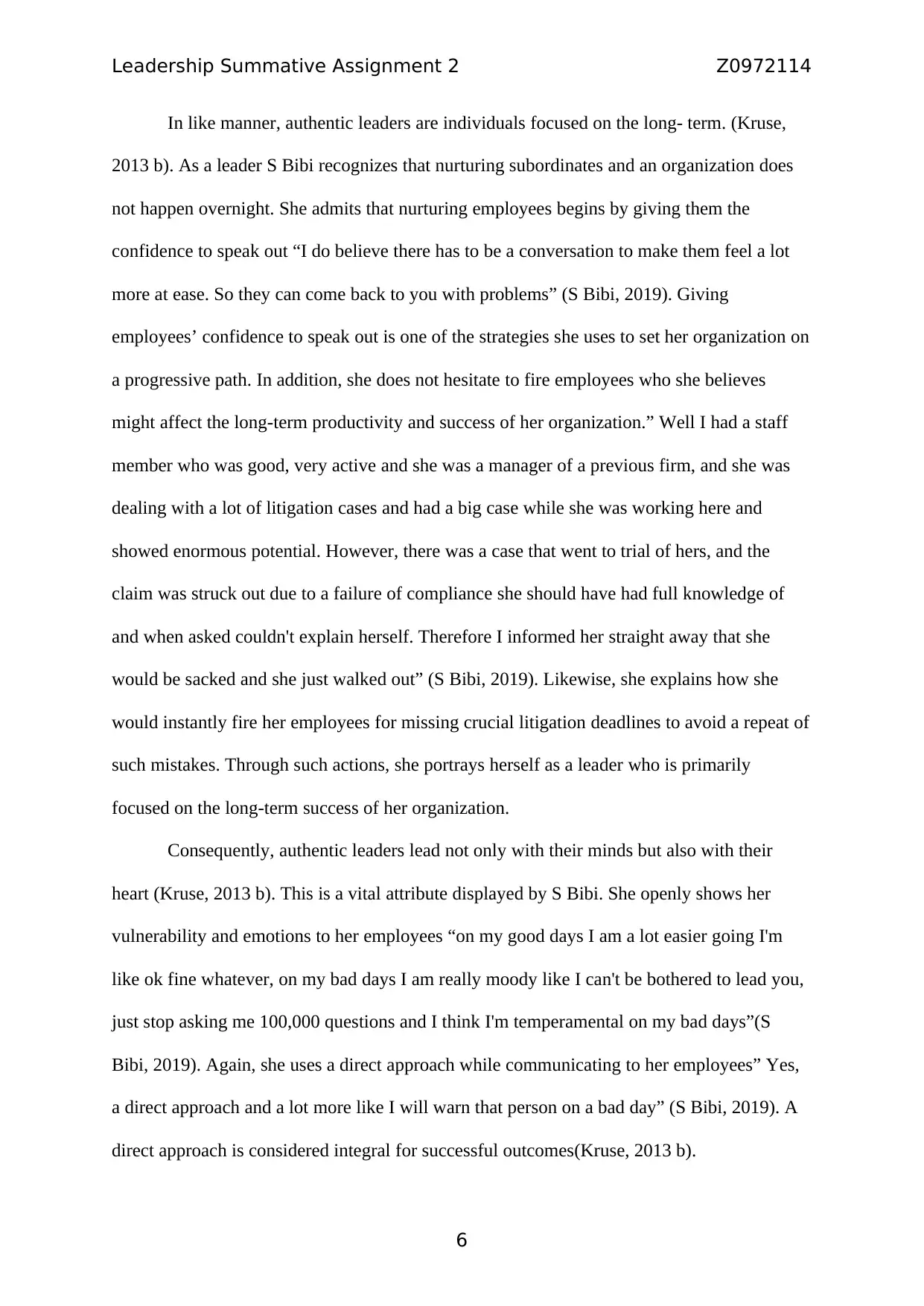
Leadership Summative Assignment 2 Z0972114
In like manner, authentic leaders are individuals focused on the long- term. (Kruse,
2013 b). As a leader S Bibi recognizes that nurturing subordinates and an organization does
not happen overnight. She admits that nurturing employees begins by giving them the
confidence to speak out “I do believe there has to be a conversation to make them feel a lot
more at ease. So they can come back to you with problems” (S Bibi, 2019). Giving
employees’ confidence to speak out is one of the strategies she uses to set her organization on
a progressive path. In addition, she does not hesitate to fire employees who she believes
might affect the long-term productivity and success of her organization.” Well I had a staff
member who was good, very active and she was a manager of a previous firm, and she was
dealing with a lot of litigation cases and had a big case while she was working here and
showed enormous potential. However, there was a case that went to trial of hers, and the
claim was struck out due to a failure of compliance she should have had full knowledge of
and when asked couldn't explain herself. Therefore I informed her straight away that she
would be sacked and she just walked out” (S Bibi, 2019). Likewise, she explains how she
would instantly fire her employees for missing crucial litigation deadlines to avoid a repeat of
such mistakes. Through such actions, she portrays herself as a leader who is primarily
focused on the long-term success of her organization.
Consequently, authentic leaders lead not only with their minds but also with their
heart (Kruse, 2013 b). This is a vital attribute displayed by S Bibi. She openly shows her
vulnerability and emotions to her employees “on my good days I am a lot easier going I'm
like ok fine whatever, on my bad days I am really moody like I can't be bothered to lead you,
just stop asking me 100,000 questions and I think I'm temperamental on my bad days”(S
Bibi, 2019). Again, she uses a direct approach while communicating to her employees” Yes,
a direct approach and a lot more like I will warn that person on a bad day” (S Bibi, 2019). A
direct approach is considered integral for successful outcomes(Kruse, 2013 b).
6
In like manner, authentic leaders are individuals focused on the long- term. (Kruse,
2013 b). As a leader S Bibi recognizes that nurturing subordinates and an organization does
not happen overnight. She admits that nurturing employees begins by giving them the
confidence to speak out “I do believe there has to be a conversation to make them feel a lot
more at ease. So they can come back to you with problems” (S Bibi, 2019). Giving
employees’ confidence to speak out is one of the strategies she uses to set her organization on
a progressive path. In addition, she does not hesitate to fire employees who she believes
might affect the long-term productivity and success of her organization.” Well I had a staff
member who was good, very active and she was a manager of a previous firm, and she was
dealing with a lot of litigation cases and had a big case while she was working here and
showed enormous potential. However, there was a case that went to trial of hers, and the
claim was struck out due to a failure of compliance she should have had full knowledge of
and when asked couldn't explain herself. Therefore I informed her straight away that she
would be sacked and she just walked out” (S Bibi, 2019). Likewise, she explains how she
would instantly fire her employees for missing crucial litigation deadlines to avoid a repeat of
such mistakes. Through such actions, she portrays herself as a leader who is primarily
focused on the long-term success of her organization.
Consequently, authentic leaders lead not only with their minds but also with their
heart (Kruse, 2013 b). This is a vital attribute displayed by S Bibi. She openly shows her
vulnerability and emotions to her employees “on my good days I am a lot easier going I'm
like ok fine whatever, on my bad days I am really moody like I can't be bothered to lead you,
just stop asking me 100,000 questions and I think I'm temperamental on my bad days”(S
Bibi, 2019). Again, she uses a direct approach while communicating to her employees” Yes,
a direct approach and a lot more like I will warn that person on a bad day” (S Bibi, 2019). A
direct approach is considered integral for successful outcomes(Kruse, 2013 b).
6
⊘ This is a preview!⊘
Do you want full access?
Subscribe today to unlock all pages.

Trusted by 1+ million students worldwide
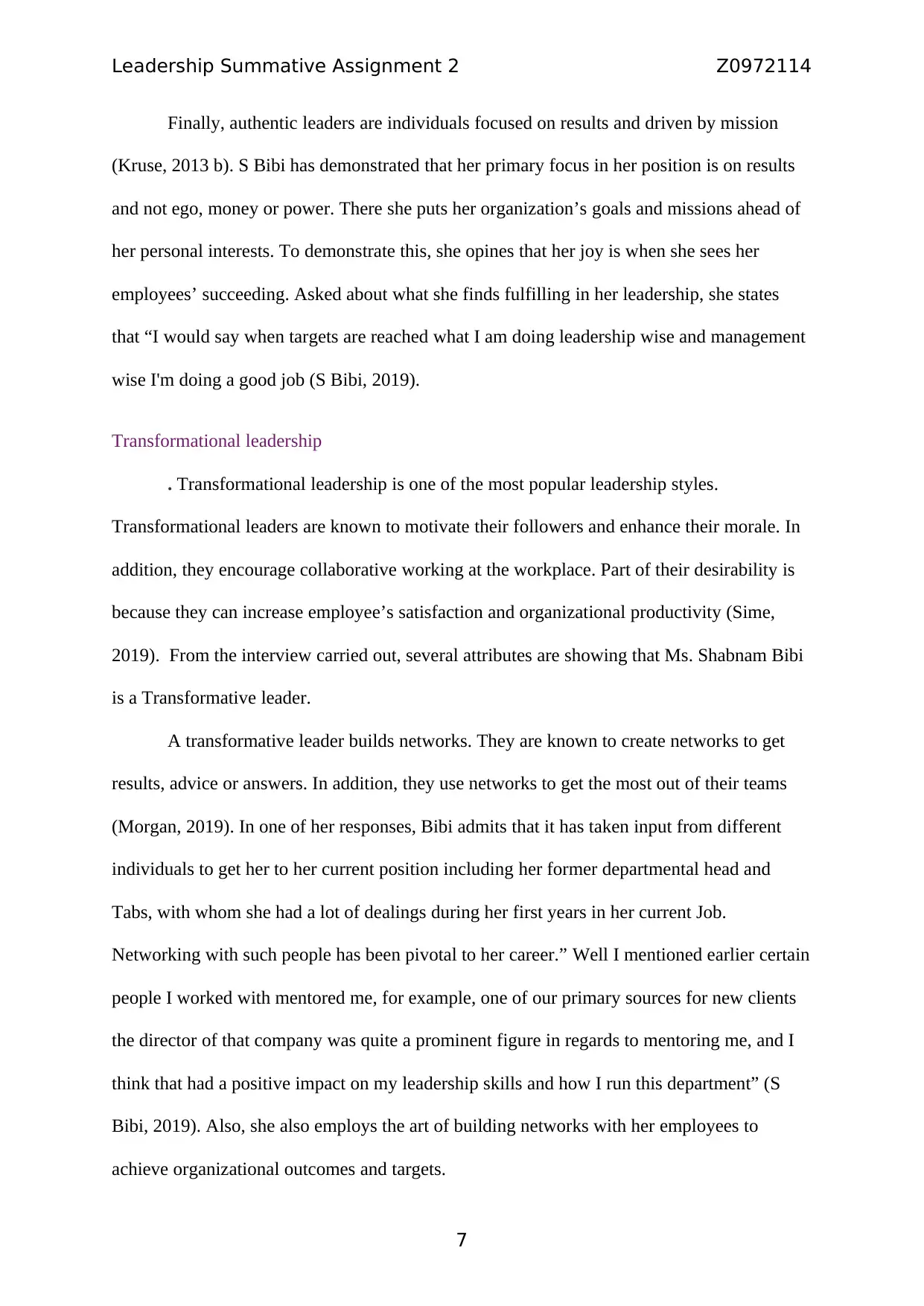
Leadership Summative Assignment 2 Z0972114
Finally, authentic leaders are individuals focused on results and driven by mission
(Kruse, 2013 b). S Bibi has demonstrated that her primary focus in her position is on results
and not ego, money or power. There she puts her organization’s goals and missions ahead of
her personal interests. To demonstrate this, she opines that her joy is when she sees her
employees’ succeeding. Asked about what she finds fulfilling in her leadership, she states
that “I would say when targets are reached what I am doing leadership wise and management
wise I'm doing a good job (S Bibi, 2019).
Transformational leadership
. Transformational leadership is one of the most popular leadership styles.
Transformational leaders are known to motivate their followers and enhance their morale. In
addition, they encourage collaborative working at the workplace. Part of their desirability is
because they can increase employee’s satisfaction and organizational productivity (Sime,
2019). From the interview carried out, several attributes are showing that Ms. Shabnam Bibi
is a Transformative leader.
A transformative leader builds networks. They are known to create networks to get
results, advice or answers. In addition, they use networks to get the most out of their teams
(Morgan, 2019). In one of her responses, Bibi admits that it has taken input from different
individuals to get her to her current position including her former departmental head and
Tabs, with whom she had a lot of dealings during her first years in her current Job.
Networking with such people has been pivotal to her career.” Well I mentioned earlier certain
people I worked with mentored me, for example, one of our primary sources for new clients
the director of that company was quite a prominent figure in regards to mentoring me, and I
think that had a positive impact on my leadership skills and how I run this department” (S
Bibi, 2019). Also, she also employs the art of building networks with her employees to
achieve organizational outcomes and targets.
7
Finally, authentic leaders are individuals focused on results and driven by mission
(Kruse, 2013 b). S Bibi has demonstrated that her primary focus in her position is on results
and not ego, money or power. There she puts her organization’s goals and missions ahead of
her personal interests. To demonstrate this, she opines that her joy is when she sees her
employees’ succeeding. Asked about what she finds fulfilling in her leadership, she states
that “I would say when targets are reached what I am doing leadership wise and management
wise I'm doing a good job (S Bibi, 2019).
Transformational leadership
. Transformational leadership is one of the most popular leadership styles.
Transformational leaders are known to motivate their followers and enhance their morale. In
addition, they encourage collaborative working at the workplace. Part of their desirability is
because they can increase employee’s satisfaction and organizational productivity (Sime,
2019). From the interview carried out, several attributes are showing that Ms. Shabnam Bibi
is a Transformative leader.
A transformative leader builds networks. They are known to create networks to get
results, advice or answers. In addition, they use networks to get the most out of their teams
(Morgan, 2019). In one of her responses, Bibi admits that it has taken input from different
individuals to get her to her current position including her former departmental head and
Tabs, with whom she had a lot of dealings during her first years in her current Job.
Networking with such people has been pivotal to her career.” Well I mentioned earlier certain
people I worked with mentored me, for example, one of our primary sources for new clients
the director of that company was quite a prominent figure in regards to mentoring me, and I
think that had a positive impact on my leadership skills and how I run this department” (S
Bibi, 2019). Also, she also employs the art of building networks with her employees to
achieve organizational outcomes and targets.
7
Paraphrase This Document
Need a fresh take? Get an instant paraphrase of this document with our AI Paraphraser
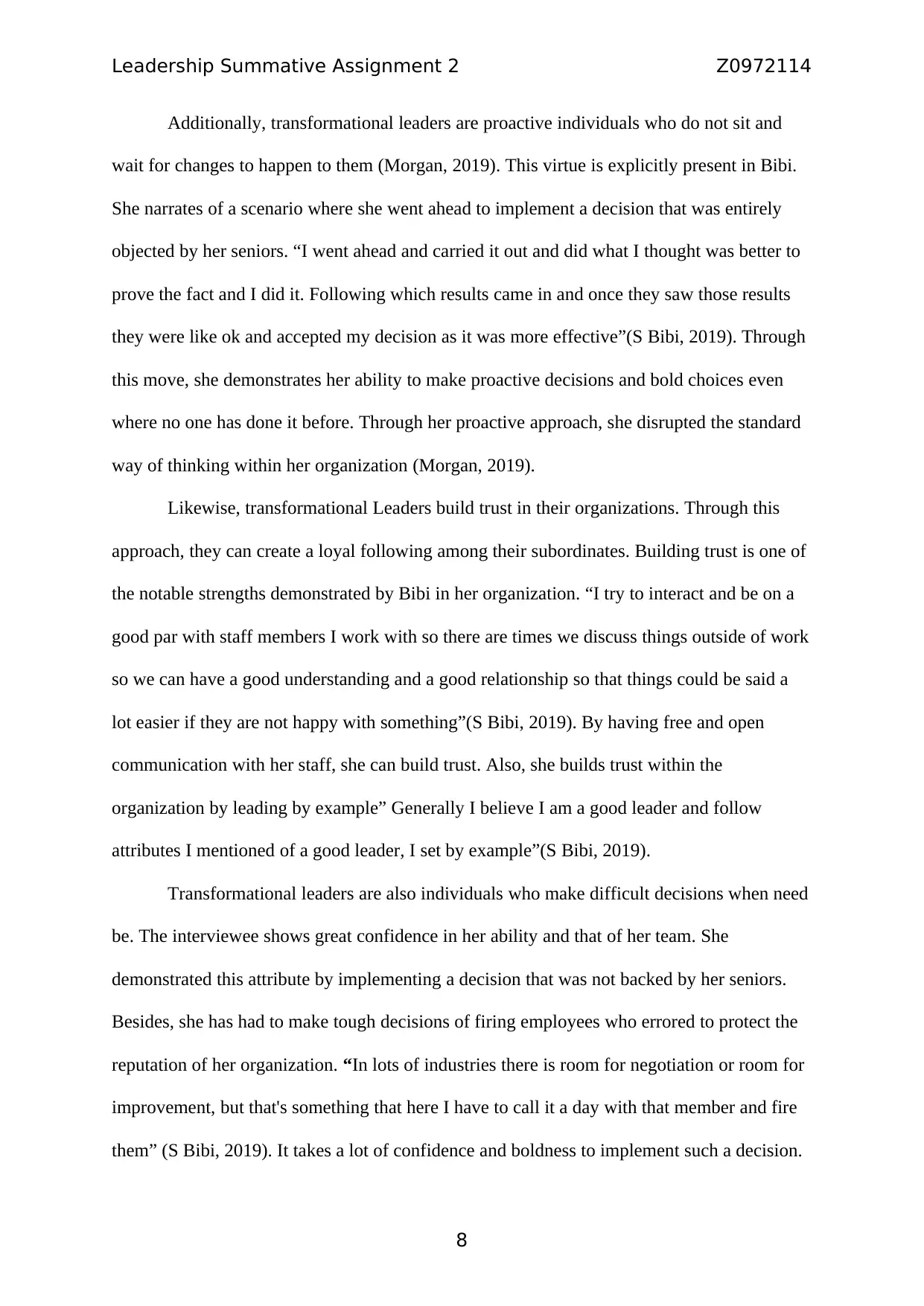
Leadership Summative Assignment 2 Z0972114
Additionally, transformational leaders are proactive individuals who do not sit and
wait for changes to happen to them (Morgan, 2019). This virtue is explicitly present in Bibi.
She narrates of a scenario where she went ahead to implement a decision that was entirely
objected by her seniors. “I went ahead and carried it out and did what I thought was better to
prove the fact and I did it. Following which results came in and once they saw those results
they were like ok and accepted my decision as it was more effective”(S Bibi, 2019). Through
this move, she demonstrates her ability to make proactive decisions and bold choices even
where no one has done it before. Through her proactive approach, she disrupted the standard
way of thinking within her organization (Morgan, 2019).
Likewise, transformational Leaders build trust in their organizations. Through this
approach, they can create a loyal following among their subordinates. Building trust is one of
the notable strengths demonstrated by Bibi in her organization. “I try to interact and be on a
good par with staff members I work with so there are times we discuss things outside of work
so we can have a good understanding and a good relationship so that things could be said a
lot easier if they are not happy with something”(S Bibi, 2019). By having free and open
communication with her staff, she can build trust. Also, she builds trust within the
organization by leading by example” Generally I believe I am a good leader and follow
attributes I mentioned of a good leader, I set by example”(S Bibi, 2019).
Transformational leaders are also individuals who make difficult decisions when need
be. The interviewee shows great confidence in her ability and that of her team. She
demonstrated this attribute by implementing a decision that was not backed by her seniors.
Besides, she has had to make tough decisions of firing employees who errored to protect the
reputation of her organization. “In lots of industries there is room for negotiation or room for
improvement, but that's something that here I have to call it a day with that member and fire
them” (S Bibi, 2019). It takes a lot of confidence and boldness to implement such a decision.
8
Additionally, transformational leaders are proactive individuals who do not sit and
wait for changes to happen to them (Morgan, 2019). This virtue is explicitly present in Bibi.
She narrates of a scenario where she went ahead to implement a decision that was entirely
objected by her seniors. “I went ahead and carried it out and did what I thought was better to
prove the fact and I did it. Following which results came in and once they saw those results
they were like ok and accepted my decision as it was more effective”(S Bibi, 2019). Through
this move, she demonstrates her ability to make proactive decisions and bold choices even
where no one has done it before. Through her proactive approach, she disrupted the standard
way of thinking within her organization (Morgan, 2019).
Likewise, transformational Leaders build trust in their organizations. Through this
approach, they can create a loyal following among their subordinates. Building trust is one of
the notable strengths demonstrated by Bibi in her organization. “I try to interact and be on a
good par with staff members I work with so there are times we discuss things outside of work
so we can have a good understanding and a good relationship so that things could be said a
lot easier if they are not happy with something”(S Bibi, 2019). By having free and open
communication with her staff, she can build trust. Also, she builds trust within the
organization by leading by example” Generally I believe I am a good leader and follow
attributes I mentioned of a good leader, I set by example”(S Bibi, 2019).
Transformational leaders are also individuals who make difficult decisions when need
be. The interviewee shows great confidence in her ability and that of her team. She
demonstrated this attribute by implementing a decision that was not backed by her seniors.
Besides, she has had to make tough decisions of firing employees who errored to protect the
reputation of her organization. “In lots of industries there is room for negotiation or room for
improvement, but that's something that here I have to call it a day with that member and fire
them” (S Bibi, 2019). It takes a lot of confidence and boldness to implement such a decision.
8
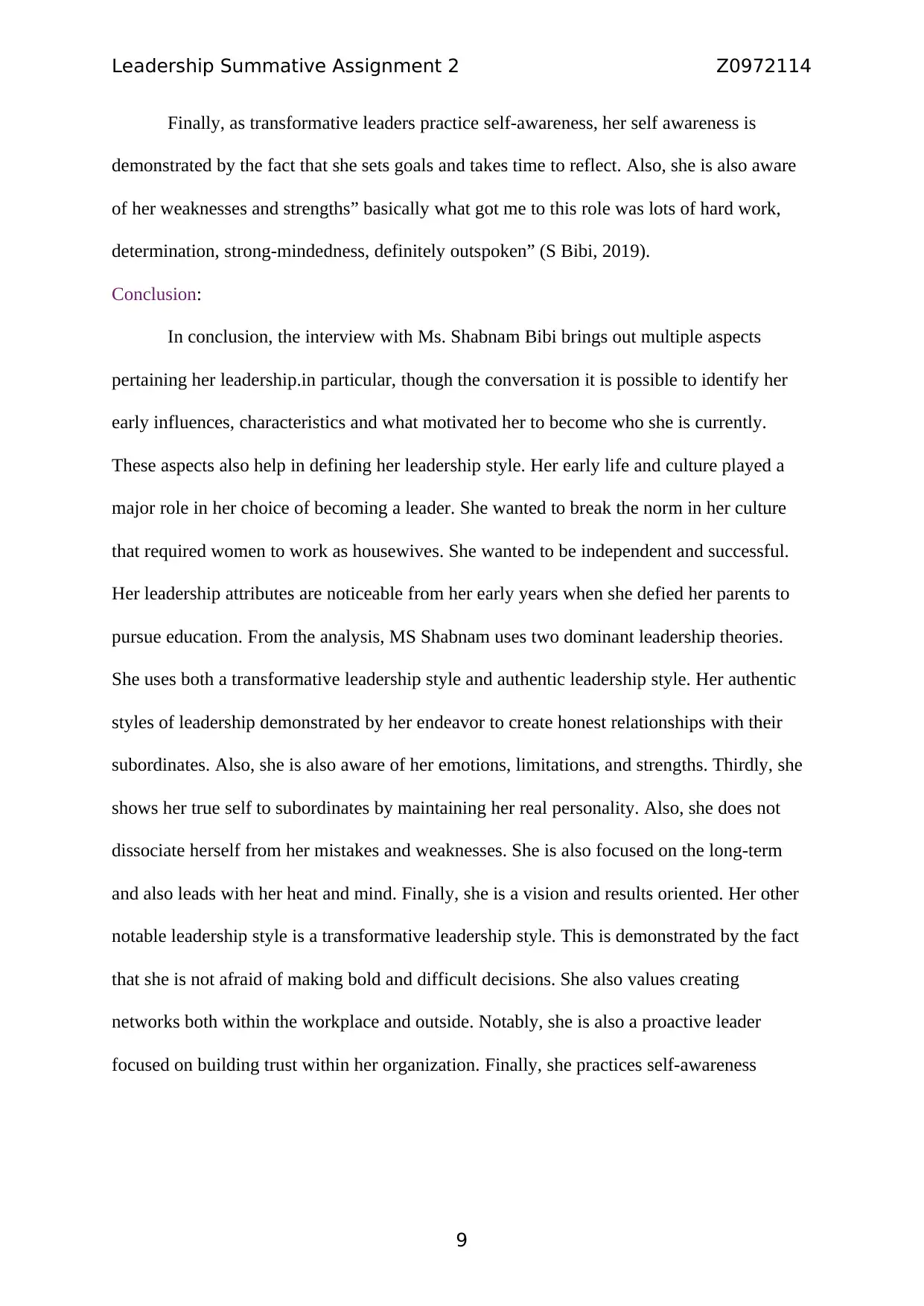
Leadership Summative Assignment 2 Z0972114
Finally, as transformative leaders practice self-awareness, her self awareness is
demonstrated by the fact that she sets goals and takes time to reflect. Also, she is also aware
of her weaknesses and strengths” basically what got me to this role was lots of hard work,
determination, strong-mindedness, definitely outspoken” (S Bibi, 2019).
Conclusion:
In conclusion, the interview with Ms. Shabnam Bibi brings out multiple aspects
pertaining her leadership.in particular, though the conversation it is possible to identify her
early influences, characteristics and what motivated her to become who she is currently.
These aspects also help in defining her leadership style. Her early life and culture played a
major role in her choice of becoming a leader. She wanted to break the norm in her culture
that required women to work as housewives. She wanted to be independent and successful.
Her leadership attributes are noticeable from her early years when she defied her parents to
pursue education. From the analysis, MS Shabnam uses two dominant leadership theories.
She uses both a transformative leadership style and authentic leadership style. Her authentic
styles of leadership demonstrated by her endeavor to create honest relationships with their
subordinates. Also, she is also aware of her emotions, limitations, and strengths. Thirdly, she
shows her true self to subordinates by maintaining her real personality. Also, she does not
dissociate herself from her mistakes and weaknesses. She is also focused on the long-term
and also leads with her heat and mind. Finally, she is a vision and results oriented. Her other
notable leadership style is a transformative leadership style. This is demonstrated by the fact
that she is not afraid of making bold and difficult decisions. She also values creating
networks both within the workplace and outside. Notably, she is also a proactive leader
focused on building trust within her organization. Finally, she practices self-awareness
9
Finally, as transformative leaders practice self-awareness, her self awareness is
demonstrated by the fact that she sets goals and takes time to reflect. Also, she is also aware
of her weaknesses and strengths” basically what got me to this role was lots of hard work,
determination, strong-mindedness, definitely outspoken” (S Bibi, 2019).
Conclusion:
In conclusion, the interview with Ms. Shabnam Bibi brings out multiple aspects
pertaining her leadership.in particular, though the conversation it is possible to identify her
early influences, characteristics and what motivated her to become who she is currently.
These aspects also help in defining her leadership style. Her early life and culture played a
major role in her choice of becoming a leader. She wanted to break the norm in her culture
that required women to work as housewives. She wanted to be independent and successful.
Her leadership attributes are noticeable from her early years when she defied her parents to
pursue education. From the analysis, MS Shabnam uses two dominant leadership theories.
She uses both a transformative leadership style and authentic leadership style. Her authentic
styles of leadership demonstrated by her endeavor to create honest relationships with their
subordinates. Also, she is also aware of her emotions, limitations, and strengths. Thirdly, she
shows her true self to subordinates by maintaining her real personality. Also, she does not
dissociate herself from her mistakes and weaknesses. She is also focused on the long-term
and also leads with her heat and mind. Finally, she is a vision and results oriented. Her other
notable leadership style is a transformative leadership style. This is demonstrated by the fact
that she is not afraid of making bold and difficult decisions. She also values creating
networks both within the workplace and outside. Notably, she is also a proactive leader
focused on building trust within her organization. Finally, she practices self-awareness
9
⊘ This is a preview!⊘
Do you want full access?
Subscribe today to unlock all pages.

Trusted by 1+ million students worldwide

Leadership Summative Assignment 2 Z0972114
References:
Morgan, B. (2019). The 10 Habits Of Transformational Leaders. [online] Forbes.com.
Available at: https://www.forbes.com/sites/blakemorgan/2019/02/25/the-10-habits-of-
transformational-leaders/#625fb036343b [Accessed 10 May 2019].
Kruse, K. (2013). What Is Leadership?. [online] Forbes.com. Available at:
https://www.forbes.com/sites/kevinkruse/2013/04/09/what-is-leadership/#24259cc65b90.
Kruse, K. (2013). What Is Authentic Leadership?. [online] Forbes.com. Available at:
https://www.forbes.com/sites/kevinkruse/2013/05/12/what-is-authentic-leadership/
#16f85530def7 [Accessed 10 May 2019].
Sime, C. (2019). The Secret To Transformational Leadership. [online] Forbes.com. Available
at: https://www.forbes.com/sites/carleysime/2019/02/05/the-secret-to-transformational-
leadership/ [Accessed 10 May 2019].
Werhane, P. and Painter-Morland, M. (2011). Leadership, Gender, and
Organization. Leadership, Gender, and Organization, pp.1-8.
10
References:
Morgan, B. (2019). The 10 Habits Of Transformational Leaders. [online] Forbes.com.
Available at: https://www.forbes.com/sites/blakemorgan/2019/02/25/the-10-habits-of-
transformational-leaders/#625fb036343b [Accessed 10 May 2019].
Kruse, K. (2013). What Is Leadership?. [online] Forbes.com. Available at:
https://www.forbes.com/sites/kevinkruse/2013/04/09/what-is-leadership/#24259cc65b90.
Kruse, K. (2013). What Is Authentic Leadership?. [online] Forbes.com. Available at:
https://www.forbes.com/sites/kevinkruse/2013/05/12/what-is-authentic-leadership/
#16f85530def7 [Accessed 10 May 2019].
Sime, C. (2019). The Secret To Transformational Leadership. [online] Forbes.com. Available
at: https://www.forbes.com/sites/carleysime/2019/02/05/the-secret-to-transformational-
leadership/ [Accessed 10 May 2019].
Werhane, P. and Painter-Morland, M. (2011). Leadership, Gender, and
Organization. Leadership, Gender, and Organization, pp.1-8.
10
1 out of 10
Your All-in-One AI-Powered Toolkit for Academic Success.
+13062052269
info@desklib.com
Available 24*7 on WhatsApp / Email
![[object Object]](/_next/static/media/star-bottom.7253800d.svg)
Unlock your academic potential
Copyright © 2020–2025 A2Z Services. All Rights Reserved. Developed and managed by ZUCOL.


